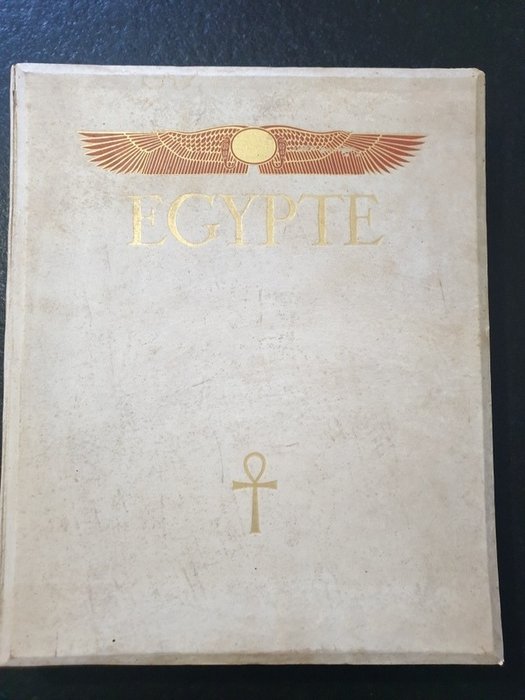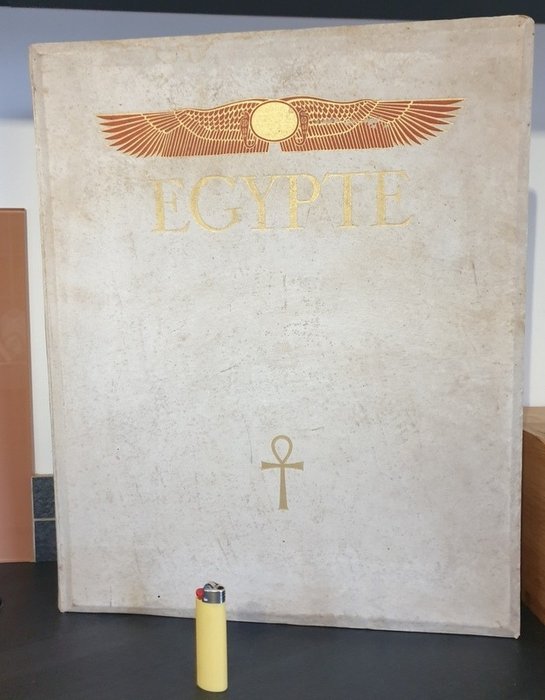Advert Description
Are you interested in this item? This item is up for auction at Catawiki. Please click on "respond to advert" (orange button) to get redirected to the Catawiki website. Catawiki’s goal is to make special objects universally available. Our weekly auctions feature thousands of unusual, rare, and exceptional objects you won’t find in just any store. RARE
Egypt
By Fred Boissonnas
Editions Paul Trembley in Geneva, 1932
Original edition
With the collaboration of Gustave Jequier, Pierre Jouguet, Henri Munier, Paul Trembley and Gaston Wiet
Copy n°139/338 for Jean Morin
Hand-signed by the author and publisher, work that will never be reprinted
Format in-Folio: 52x44cm (Immense)
Weight: 11.4 kgs
Publisher's binding of the bookbinder Jacques Wendling (art bookbinder in Paris), in full decorated vellum
191 pages
40 photographs (1929-1930) reproduced in heliogravure under captioned scrolls and 1 map
Good general condition despite 2 detached snakes, 1 detached board, upper joint split in the head, some interior foxing
Work sought after by collectors
*Frédéric Boissonnas, born June 18, 1858 in Geneva and died October 17, 1946 in the same city, was a Swiss photographer.
Frederic Boissonnas
Biography
Birth
June 18, 1858
Geneva
Death
October 17, 1946 (aged 88)
Geneva
Nationalities
Swiss
French
Activity
Photographer
Family
The Boissonnas family
Father
Henri-Antoine Boissonnas
Siblings
Edmond-Victor Boissonnas
Children
Edmond-Edouard Boissonnas
Henri-Paul Boissonnas
Paul Boissonnas
Other information
Distinction
Charles Blanc Prize (1911)
Archives kept by
Hellenic Literary and Historical Archives (d)
MOMus–Thessaloniki Photography Museum
Geneva Library
Biography
Childhood and family
He came from a family of Geneva artists, his father was Henri-Antoine Boissonnas (1833–1889), watch engraver then photographer, and his mother was Sophie Pilet (1836–1918), designer of watch cases. He was the first child of a sibling composed of Caroline Sophie Boissonnas (1859–1943), Edmond-Victor Boissonnas (1862–1890) and Eva Boissonnas (1873–1965). He spent his childhood in Geneva. Enrolled at the Ecole Privat, he continued his studies at the Collège Calvin. He studied drawing at the School of Fine Arts, with the painter Barthélemy Menn.
In April 1890, he married Augusta Magnin (1864–1940). They will have 9 children. In 1896, he bought from his ruined father-in-law Magnin, a countryside of twelve hectares, including a house, farm and land on Chemin du Pommier in Grand-Saconnex. He had a small house, a villa and a chalet built there for his family called “Les Mayens”.
In the 1930s, ruined by the various publishing companies and the global economic crises, Frédéric and Augusta Boissonnas were reduced to selling their properties piecemeal. They will end their days with their children.
The photography career
From 1879, to train in photographic techniques, he spent eight months in the studio of Friedrich Brandseph (de) in Stuttgart, before leaving in 1880 for another internship in Budapest with Károly Koller (de), the photographer of the course of Europe. Frédéric Boissonnas is Koller's assistant cameraman for these shots of high society. Above all, he learned the importance of lighting, staging and the use of painted backgrounds and other accessories for professional photography workshops.
In 1887, following his father's health problem, he decided to take over the photography studio. He will use all the tricks and new techniques learned in his previous training. The results are such that it has earned him the interest of an increasingly large public in Geneva: school classes, societies, choirs, groups come to be photographed in his studio, families and their children too. At the same time, he creates moral genre scenes (the evils of alcohol, savings) or historical scenes (the Lacustres). He also perfects the shots of natural elements and he creates tableaux vivants, stagings, directly in nature. Follower of pictorialism, he participated in many exhibitions organized by this movement in Vienna, London, Paris and Brussels.
More generally, he is known for his portraits of Genevan or international personalities, his architectural views (Geneva, documentation on the Haut-Koenigsbourg castle), landscape photographs (Alps, Mont Blanc, Valais), travels (sea Mediterranean, Greece, North Africa, Egypt, France, Holland), shows (Winegrowers' Festival of 1889, Swiss National Exhibition of 1896, Festival of June 1914 (centenary of the entry of the canton of Geneva into the Swiss Confederation), his exhibition prints (large format prints presented for example at the Universal Exhibition of 1900 in Paris), pictures of his family and loved ones.
Editions and publications
In parallel with photography, he published articles, scientific or photographic works from 1889 (like the one on La Fête des Vignerons in Vevey in 1889). F. Boissonnas participates in illustrated books, articles and various editions, advertisements as a photographer and illustrator or author. His pictures are published in Swiss or French photography magazines (Swiss Photography Review, Le Moniteur de la Photographie, Paris). The various Éditions Boissonnas will publish many photographic works or subjects relating to this theme. In 1919, the publishing company "Boissonnas SA" merged with the Sadag printing works (Geneva). The editorial adventure ended in 1923 with the bankruptcy of the publishing house.
He will also put his know-how at the service of research and the arts. He will thus work from 1900 with the protector of the heritage Guillaume Fatio and his pictures illustrate several of his books. From the summer of 1903, he collaborated with the Genevan musician and pedagogue Émile Jaques-Dalcroze. Many photographs come to illustrate the activities of Dalcroze in relation to his pedagogy called rhythmic. His surveys of the Parthenon were published in 1914 in a book by the French archaeologist Maxime Collignon and were taken up by the architect Le Corbusier in his book Vers une architecture.
Notoriety
In 1887, he was a member of the Geneva Society of Photography and he obtained a silver medal at the Toulouse photography exhibition. He will then regularly participate in exhibitions and receive awards for his work (gold medals in Bern, Vienna or Chicago). His workshop attracts an ever-increasing clientele and despite this, he continues to experiment with techniques and to do personal work, such as making images of the Alps which illustrate works on Geneva.
In 1896, the Swiss National Exhibition took place in Geneva. He took part in it and occupied the "Boissonnas pavilion". On the ground floor, he exhibits his work there and, on the first floor, he has installed his “Cyclorama”, a kind of camera obscura on a human scale (dark room). On this occasion, he published two albums of original prints on the section called the “Swiss Village”, one of the attractions of the exhibition. They will sell very well throughout Switzerland and carry its notoriety beyond Geneva. On August 8, 1896, he received the gold medal of the exhibition, which made him the most famous photographer in Switzerland. At this time, he also launched into images intended for advertising and tourism (Nestlé, Yverdon-Sainte-Croix railway line).
In August 1900, an international jury awarded him the grand prize for photography, a considerable distinction at the Universal Exhibition in Paris.
The different workshops
In addition to his studio in Geneva, Frédéric Boissonnas will export his know-how and benefit from his notoriety by opening several workshops in Europe.
In 1901, Frédéric Boissonnas and André Taponier joined forces to found a photography studio in Paris at 12, rue de la Paix, the Maison Boissonnas-Taponier. They will end up falling out.
In 1902, he bought Pierre Bellingard's studio in Lyon to install his wife's brother, Charles Magnin. He also bought Nadar's studio in Marseille and placed a student there, Fernand Detaille, and created the Maison Nadar-Boissonnas & Detaille. He again allied himself with the German Fritz Eggler and took over the studio of Alexander Pasetti (de) in Saint Petersburg.
In 1923, he took over the Chéri-Rousseau workshop in Paris, which was closed in 1927.
travel and books
Around 1900, he became friends with the Geneva writer Daniel Baud-Bovy with whom he carried out numerous projects, both trips and publications. A Scotsman, Lord Thomas George Napier, bought him one of his spectacular images of Mont Blanc, a photograph taken with a telephoto lens in 1888 and awarded at the Universal Exhibition in Paris in 1900. In May 1903, Thomas George Napier commissioned him to go photographs of Mount Parnassus in Greece, on the same model as those made of Mont Blanc. He accepted and left on April 13, 1903 for Greece with Daniel Baud-Bovy and their respective wives.
Between 1907 and 1919, he made several trips to Greece. In 1907, he took the photographs for the book In Greece by mountains and valleys, which was to be published in August 1910, when Daniel Baud-Bovy wrote the text. In October 1907, he was in Egypt, in Cairo, which he visited.
In 1911, the French Academy awarded him the Charles-Blanc Prize, with Daniel Baud-Bovy as co-author, for their work In Greece by mountains and valleys. In 1911, Frédéric Boissonnas and Daniel Baud-Bovy returned to Greece to explore Crete and the Cyclades. They plan to do a second book.
In July 1912, Frédéric Boissonnas is with the French Hellenist Victor Bérard for a three-month journey. They sail in the Mediterranean in the footsteps of Ulysses, to explore the significant places he visits and which are described in the Odyssey. Following his travels with Victor Bérard, the latter published Dans le sillage d'Ulysse.
In 1913, he returned to Greece with Daniel Baud-Bovy with whom he made the first known ascent of Mount Olympus on August 2. He is doing a photography campaign on the Acropolis of Athens. He travels to Epirus and Macedonia during the Balkan Wars. In 1914, he traveled to Algeria. The First World War broke out and precipitated its activities into serious financial difficulties.
In 1919, he left for Greece and Serbia accompanied by his sons Edmond-Édouard Boissonnas and Henri-Paul Boissonnas. Following these trips, he published 14 photographic albums dedicated to Greece in a collection entitled L'image de la Amérique , which promotes Greek identity in Europe as well as the country's tourist attractions. He returned there in 1920 and 1927 for a second ascent of Mount Olympus and the making of a documentary film (he was then accompanied by his son Paul Boissonnas). His photographic vision of Greece, which captures the remains of Antiquity (including the Acropolis of Athens), the landscapes and the populations, will participate in the creation of a "collective portrait" of this country at a time when it builds itself.
In 1929, he was again in Egypt to prepare a luxurious work, with his sponsor, the Geneva engineer Paul Tremblay, who paid for the shipping. A contract is signed with the Egyptian government to produce this art book entitled Egypt. Between 1929-1930 and with the help of the Egyptian government, they crisscrossed the country to carry out photographic campaigns. Between 1931-1932, the book was produced between Cairo, Geneva and Paris, with the collaboration of Gustave Jéquier, Pierre Jouguet, Henri Munier and Gaston Wiet. In March 1933, they presented a copy to King Fouad I who gave them his approval. The latter also requested its official launch from the Geographical Society of Cairo: the presentation of the book took place on April 3, 1933 in front of a crowd of 300 Egyptian notables and dignitaries. However, despite this promising start, the success of this luxurious publication will be compromised by the exorbitant subscription price of the book (1,000 Frs) and the world crisis.
Still in Egypt between May and June 1933 with Paul Tremblay, Boissonnas carried out his last photographic campaign there and his second trip from Suez to Mount Sinai and the Saint-Catherine monastery. He hopes to draw from the photographs that he makes there a work provisionally entitled SinaÏ, but it will never appear.
66934837





